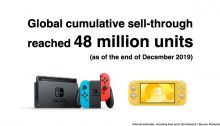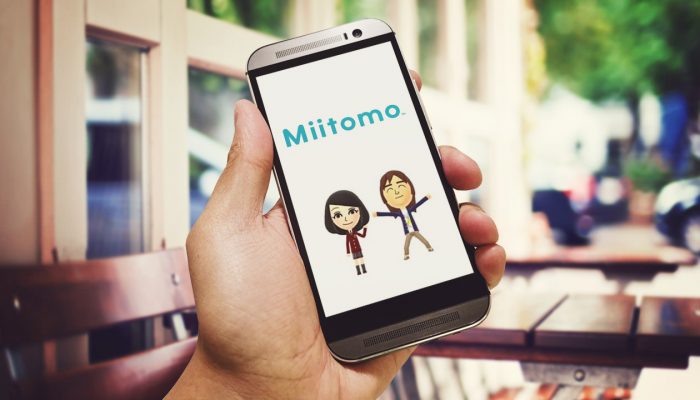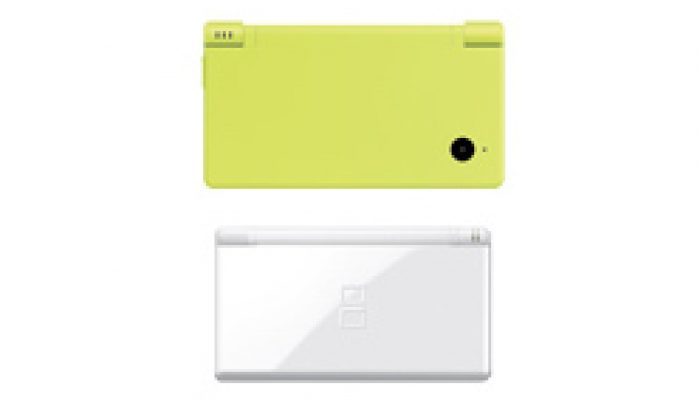 “In terms of the hardware, I think we will be able to consider a variety of ways to expand in the future.”
“In terms of the hardware, I think we will be able to consider a variety of ways to expand in the future.”
☆ NintendObs Event – Nintendo Q3 FY3/2020.
Question 1:
Now that the holiday season is over, what changes have there been to the ratio of consumers who purchased Nintendo Switch Lite as their second system in the Nintendo Switch family? Is the overall Nintendo Switch user base expanding favorably?
Answer 1:
Shuntaro Furukawa (Representative Director and President):
At the six months financial results briefing, we noted that the percentage of consumers who purchased Nintendo Switch Lite as their second Nintendo Switch system was 43%. As of now, with the holiday season behind us, that ratio is around 30%. As mentioned in the presentation earlier, our flagship Nintendo Switch continues to have strong momentum, and sales of Nintendo Switch Lite are only adding to that. One reason for this, besides the demand for a second system, has been the newest additions to the Pokémon series. A trend we’ve seen among consumers who’ve previously played Pokémon titles on handheld systems is that some are choosing to buy the Nintendo Switch Lite dedicated handheld system. We’ve also confirmed that women account for a high percentage of consumers who are choosing to purchase Nintendo Switch Lite as their first system in the Nintendo Switch family. For these reasons, we are seeing that the launch of Nintendo Switch Lite is expanding the user base.
And looking at the Nintendo Switch family as a whole, the release of software like Ring Fit Adventure is likewise helping us reach female consumers and a wider range of age groups. That said, I believe there are still opportunities to increase the specific demand for Nintendo Switch Lite. The task going forward is to figure out where those opportunities lie, and how we can engage with consumers so that even more can experience and purchase Nintendo Switch Lite.
Question 2:
What are your thoughts on the business cycle, based on the trends for Nintendo Switch at the end of its third holiday season? Do you believe the Nintendo Switch lifecycle will be different from past cycles? And if so, do you think the business can expand even after growth in unit hardware sales has plateaued somewhat, or do you intend to prolong the lifecycle by diversifying the family with more hardware variations like Nintendo Switch Lite?
Answer 2:
Furukawa:
With Nintendo Switch about to begin its fourth year, the situation does feel a little different from the home consoles we’ve offered in the past. In addition to Nintendo Switch being a home console you can take on the go, we’re also offering Nintendo Switch Lite as a dedicated handheld version, and consumers can choose whichever best matches their lifestyle. In terms of the hardware, I think we will be able to consider a variety of ways to expand in the future.
The software is no less important. As explained in the presentation, our focus now will be on the Nintendo Switch platform with its growing installed base. By focusing our software development resources on Nintendo Switch, I believe its lifecycle will follow a course that is different from our previous Nintendo home consoles.
Question 3:
You shared (during the presentation) the idea of launching different hardware variations to match changing lifestyles. Now that the way people play games is changing, and the hardware is changing accordingly, I’m wondering if the way you make games is also changing. I’d also like to hear whether “ways to play” is also the focus of your hardware development, which isn’t much related to performance or specifications.
Answer 3:
Shigeru Miyamoto (Representative Director, Fellow):
Our focus in software development has always been on “ways to play,” so I don’t feel there has been much of a change from our usual way of making games. When I started my career, video games were not yet widespread as a form of entertainment. The advent of video games as an entertainment medium has given birth to interactive play (where your actions result in an immediate effect). When creators like us were starting to get bored because we couldn’t create new ways to play, or were just redoing the same kinds of ideas on our single hardware platform, new hardware and new technologies emerged and helped evolve video games. The fact that we were able to design the new hardware, including the design of the interface such as the controllers, in order to make new games has greatly expanded the possibilities for play in video games.
Now, with the spread of smart devices, our dream of people throughout the world playing games is becoming a reality. A lot of people have bought Nintendo Switch, but there are still many who do not know about it. Considering the number of people who interact with digital content on smart devices, I feel that the size of the game market still has unlimited potential.
We are not bound by the conventional framework of game creation, and the possibilities for freely creating completely new kinds of play are expanding. I’m personally very pleased with where we are right now. And from a business perspective, we are in an era where a single idea can give rise to a variety of new business opportunities. The expanding possibilities of the digital business seem like an especially good opportunity to propose new ways of play, which is something Nintendo always tries to do. So I think there’s a lot you can look forward to.
Ko Shiota (Director, Senior Executive Officer):
Since the launch of Nintendo Switch, I’ve been paying attention to how it is played and noticed that the ways in which consumers play are changing. The variety of situations in which consumers are playing Nintendo Switch goes beyond what we imagined as its developers. A product like Nintendo Switch wouldn’t have happened had we simply jumped on the technology bandwagon and worked to create the highest-spec hardware. The “hardware” we create is a dedicated system for playing games, and as a dedicated video game system, it should be a device that enables people to enjoy quality game experiences in whatever way is most comfortable for them in a given situation. In our hardware development, we are constantly looking for technologies that can best deliver those kinds of experiences, and studying how we can offer them in unique Nintendo-like ways.
Question 4:
I’d like to hear about your IP development strategies for things like a movie and theme parks. Many companies are landing on the idea of using their IP to increase the number of people who interact with their content, which I think is intensifying the competition within the IP-based content industry. I do think that Nintendo’s content is unique because it has evolved along with how the world of the game and “the feel of the game” have evolved. I’d like to know how Nintendo’s IP expansion strategy differs from that of other companies.
Answer 4:
Miyamoto:
We’ve always worked hard to create new kinds of play, but Nintendo has long been thought of as part of a race to produce the video game hardware. Lately, I feel like that conversation about competition between Nintendo and other game companies is happening less and less. You asked how Nintendo is different from the other companies who are using their IP as their main driver to grow their brand, and that question is how I’ve come to frame my perspective on this topic as well. Only Nintendo developers can use the character of Mario as we feel best, for example, and we have closely guarded our rights so that we don’t lose that freedom in developing our games. Our stance on this point won’t change, but there is a limit to how many consumers will be able to engage with Mario if their contact point is limited to dedicated video game systems. It’s been several years since we started thinking of unique Nintendo ways to enable a wider range of people to come into contact with our characters. Taking theme parks as an example, Nintendo characters were conceived of and developed around the unique characteristic of “interactivity” (where your actions result in an immediate effect) and we’ve held this as a guiding principle as we collaborate with Universal Parks & Resorts. Universal Parks & Resorts is working with us to take on the same challenge of making something that can be called a world first. And in the area of video content, we are likewise moving towards the goal of inviting a wider range of consumers to connect with Nintendo characters.
Through mobile applications, the number of people who interact with our characters has dramatically increased. I think how we bring our IP to consumers who don’t play on Nintendo’s dedicated video game systems on a daily basis is a crucial challenge for us. Nintendo’s characters are unique in that they are recognized by people of all ages, from grandparents to their grandchildren. That recognition is highly valued by us, and we will continue to grow the number of people who come in contact with our Nintendo characters as we continue working on our unique initiatives.
Shinya Takahashi (Director, Senior Managing Executive Officer):
The Nintendo TOKYO store in SHIBUYA PARCO was born from a joint discussion between the development and business sides of the company, and is another new step towards making Nintendo characters known to the general public. Even consumers who do not own Nintendo dedicated video game systems are coming to the shop, and so far we’re seeing the results that we hoped to achieve.
Question 5:
The touchpoints that consumers have with Nintendo IP, especially Mario IP, are currently Nintendo Switch, smart devices, and the like. I understand this will expand to theme parks, a movie, and so on, but what lines separate these different media? I expect each medium probably has some certain set themes, not just introducing the Mario character anywhere. I would like to know what will be different about eachtouchpoint, and what will be the same.
Answer 5:
Miyamoto:
We have not established individual IP expansion strategies for each touchpoint. Take video content development using Nintendo IP, for example. I wasn’t in favor of the idea originally, but to give you some background on my current involvement in creating video content using our IP, consider the number of times we created Virtual Console games (a service that allowed titles released for older Nintendo hardware to be available for download and played on newer hardware). Our assets include our past software, and we can continue to leverage those assets even now, 30 years after the original titles were released. Unfortunately, when the original hardware that supported this software is no longer available, that software must be ported to new hardware. As we continue to port our older games to newer hardware, we have come to think that if we have assets in the form of video content in addition to our beloved video game titles, and if we can leverage both of these assets over the long term, then I can see how our content business could lead to further growth.
In other words, my way of thinking changed, and it’s not so much that I wanted to make a Mario movie, but that I felt Nintendo should have more video content. More people will have access to our IP with video content, and so the number of people who will come into contact with Nintendo IP will continue to grow in the future. The various mediums through which video content is available will continue to expand. As this happens, we believe that the most important thing for us will be to keep a firm hold on our rights. A critical aspect of our strategy is making our rights clear while creating content. And collaborating with other companies to create this visual content means that we have no need to expand our company’s size unnecessarily. This in turn means that we feel able to invest actively.
Question 6:
Regarding the Chinese market and the launch of Nintendo Switch in December 2019, please explain the growth potential and how you are planning to increase sales going forward.
Answer 6:
Furukawa:
We are very pleased to have launched Nintendo Switch in China in December 2019. Because the product was just launched, the extent of our sales thus far is limited. As mobile and PC games make up the bulk of the Chinese market, we are working closely over the long term with Tencent to spread the appeal of Nintendo’s unique software and the like.
Satoru Shibata (Director, Senior Executive Officer):
While the Chinese market has an extremely large population of people who play games, the majority play mobile applications or PC games, and the practice of purchasing dedicated hardware and software to play games is not yet ingrained, so we believe that it will take time for Nintendo Switch to spread through the market. Our goal with China is the same as it is for other markets: to provide a unique Nintendo Switch experience where friends and family can come together to play and smile. By doing so, we hope the appeal of Nintendo Switch will be embraced by people who currently play PC games or mobile applications, which could then lead to the system’s adoption across a wider range of audiences. Currently, demo events at retail outlets in China are being held. By actively working to raise awareness of Nintendo Switch, we would like to expand our business in China over the medium to long term.
Question 7:
I thought that monetization would accelerate with the release of Mario Kart Tour, but while the number of players has increased, it does not seem to have greatly increased sales. Is your mobile business mainly focused on expanding the number of people who have access to Nintendo IP, with not as much emphasis placed on short-term monetization? And can we expect multiple anticipated titles for smart devices to be released in the next fiscal year onward?
Answer 7:
Furukawa:
Regarding how we evaluate the current state of the mobile business, I think we’re making progress towards expanding the number of people who are in contact with Nintendo IP that is in line with our expectations. In particular, the trends in the number of downloads and players for Mario Kart Tour have shown solid progress, and we believe that opportunities to come into contact with Nintendo IP through the global prevalence of smart devices will increase, according to our expectations.
In addition, specific franchises such as Animal Crossing: Pocket Camp and Fire Emblem Heroes have built ongoing relationships with our consumers through their operations, and have become a point of contact with consumers from a different approach from that of the dedicated video game platform business.
The primary purpose of the mobile business is to bring into contact with Nintendo’s games and characters the vast number of consumers who cannot be reached via dedicated video game systems alone. Ideally, this contributes to maximizing the Nintendo business as a whole. And yes, we are definitely considering new ideas for the mobile business and continuing to work on development. We will communicate this information when we are able to announce it.
Question 8:
I would like to hear about what the positioning of the next fiscal year (ending March 31, 2021) is for Nintendo as other companies are planning to launch their new hardware. Given that Nintendo Switch is soon entering its fourth year, do you see the next fiscal year, including changes in the environment, as something of a threat or a major opportunity? Please describe your direction in terms of positioning and strategy.
Answer 8:
Furukawa:
We’ll discuss specific figures for the coming fiscal year at the next financial results announcement, but I agree there will be changes in the environment due to the appearance of new products from other companies in the same industry. That said, we believe that the position of Nintendo Switch in its lifecycle is different from that of hardware from other companies and that the consumers of our products are also different. Therefore, we do not believe that the business activities of other companies will be especially influential on Nintendo’s business. On the other hand, it is essential for us to maintain momentum for Nintendo Switch, and, as described earlier (in Question 1), we must explore the unique demand for Nintendo Switch Lite and expand its sales without slowing momentum of the original Nintendo Switch. On the software side, in addition to continuing to release new software, we believe that it is also essential to continue our efforts to extend sales of already-released software for a longer period than before.
The Nintendo Switch business will soon enter its fourth year, and we believe it is just entering the middle of its life cycle. We are looking beyond the next fiscal year to consider how to move forward in the next fiscal year and ones to come.
Question 9:
How does concentrating development on the Nintendo Switch platform impact your gross profit ratio? Are you conducting development to reduce the cost of sales ratio of the hardware? And, with respect to software, will continued sale of evergreen titles contribute to improved gross profit ratio?
Answer 9:
Furukawa:
Concentrating development on the Nintendo Switch platform will not necessarily have a direct impact on our total gross profit margin ratio. However, currently the effects of mass production and other factors have improved the gross profit margin ratio on hardware. For software, we don’t include research and development costs in the cost of goods sold, so there is no effect on gross profit margin ratio. Making continuously strong sales for titles we have already released is one way we are able to maintain high operating profit ratio, because research and development costs are expensed as selling, general and administrative expenses at the time incurred.
— Nine Months Financial Results Briefing for Fiscal Year Ending March 2020
Source: Nintendo JP.
At NintendObserver, the comments are on Discord.
Click on Community to learn more. 🙂
…
…Wanna play? Buy a Switch.
And if you’ve already got yours, here are all the games already available on the platform. 😀



